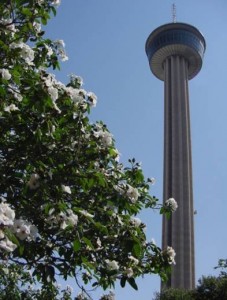May 19, 2007
Plant of the Week
by
David Rodriguez
 In the United States, Texas Olive occurs in the wild in very few locations. Historically, this Texas beauty grew no further north than certain lower Rio Grande Valley counties, including Hidalgo, Jim Hogg and Willacy. It is native to no other state in the United States. Trees may live well over 100 years.
In the United States, Texas Olive occurs in the wild in very few locations. Historically, this Texas beauty grew no further north than certain lower Rio Grande Valley counties, including Hidalgo, Jim Hogg and Willacy. It is native to no other state in the United States. Trees may live well over 100 years.
The uniquely flowering Texas Olive is also native to Nuevo Leon, San Luis Potosi, Coahuila and Tamaulipas. In those parts of Mexico, the Texas Olive is commonly referred to as the Mexican Olive (Anacahuita), pronounced ANA-COW-EAT-A. The citizens of Nuevo Leon, Mexico, honor this beautiful tree as their state flower.
Texas Olive (Cordia boissieri) was named, respectively, for Valerius Cordus, a German botanist and pharmacist of the 16th Century and Pierre-Edmond Boissier, a 19th Century botanist. The shape of the yellowish to purple colored fruit lends this tree to many common names, such as the Texas Olive, Wild Olive, and Mexican Olive (Anacahuita). Botanically speaking, the Texas Olive is NOT closely related to other types of olives but is a member of the Borage Family.
Depending on soil and overall growing conditions, this small evergreen tree reaches a typical height of 15 feet with about a 10-foot spread. This native Texan of the lower Rio Grande Valley is naturally found along stream beds and slopes, preferring a well-drained soil. Currently, the Texas Olive is becoming a rare find, and it has even been reported to be close to extinction.
The flowers of the Texas Olive are spectacular and gorgeous. Each individual flower is 1 1/2 – 2 inches or more across. The attractive blooms continue aggressively from late winter through mid to late summer. The rest of the year, the Texas Olive flowers sporadically.
This is a great hummingbird plant. The yellow-throated, tubular/funnel-like white flowers attract hummingbirds, who ardently claim an individual tree as their own. You should stop long enough to admire those little fellows on the Texas Olive, zipping around in defense of their territory. Who said those little fellows are only attracted to red-colored flowers?
Butterflies are very fond of the nectar from the Texas Olive blossom clusters. Many should have their portraits taken in the act of drinking, with their long proboscises, from the yellow throats of those two-inch trumpets. Close relatives of the Texas Olive include other butterfly favorites such as the Turnsoles (Heliotropium) and the Anacua, a highly-attractive, native tree.
Both the Texas Olive and the Anacua have large leaves in comparison to other popular Texas natives. Those of the Texas Olive are soft and grey-green. The leaves of the Anacua are sandpaper-rough, smaller and darker green.
Fruit of the Texas Olive is also useful in many ways. Many wild animals, birds and domestic cattle eat the fruit. The leaves are also consumed as forage. The fruit is edible to humans, though not very tasty and should only be consumed with great moderation. In certain parts of Mexico, leaves are used as a medicinal tea to treat rheumatism and bronchial congestion. Some people find this a soothing remedy for the misery associated with the common cold.
The Texas Olive is a drought-tolerant and frost-resistant plant, tolerating temperatures in the high 20’s. In a severe frost, Texas Olives may loose their leaves. Past severe winters, such as the freeze of 1983, caused many of the Texas Olives to freeze and die here in San Antonio. Because of cold tolerance, it is probably best to locate the tree close to the house, where heat may be better retained. Occasional pruning may be needed to create a single-trunk erect specimen.
There are few plants that will bloom almost every day throughout the year. The Texas Olive is among those few exceptions. Many specimens in the Rio Grande Valley take a rare bloom break. This might be that great plant providing the illusion of snow. After a windy day or a long awaited rain, the ground beneath the Texas Olive is often covered in fallen white blossoms.
Texas Olive is that unique flowering tree everyone is wanting. This tree will be that great, unusual plant added to your landscape. It will provide many years of great enjoyment as a small accent tree or as that beautiful decorative patio pot plant. Check it out!
Remember, Learn and Have Fun!
David Rodriguez is County Extension Agent-Horticulture, Bexar County. For more information, call the Master Gardener ‘Hotline’ at (210) 467-6575 or visit our County Extension website at http://bexar-tx.tamu.edu, click under Horticulture and Gardening.
